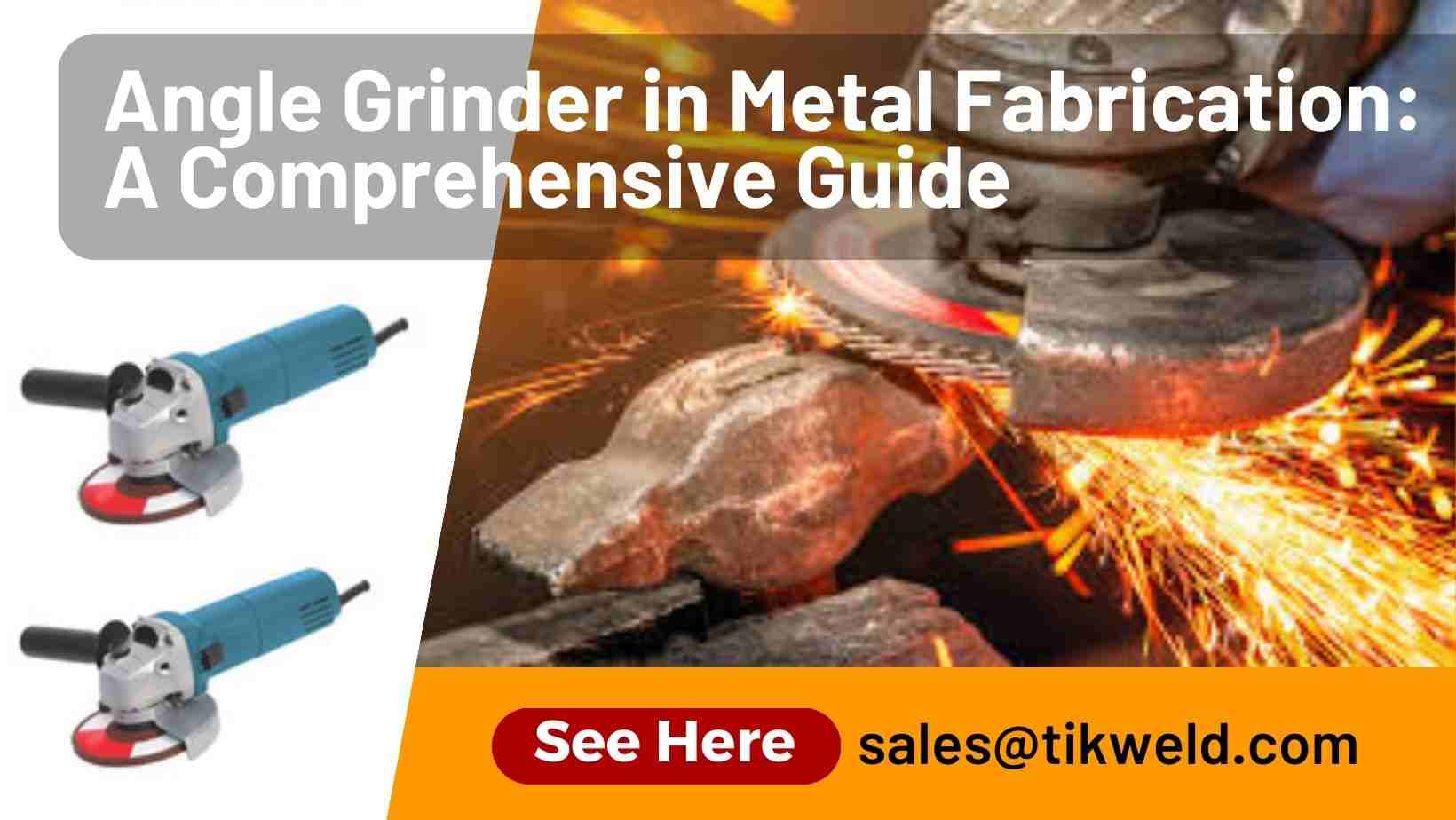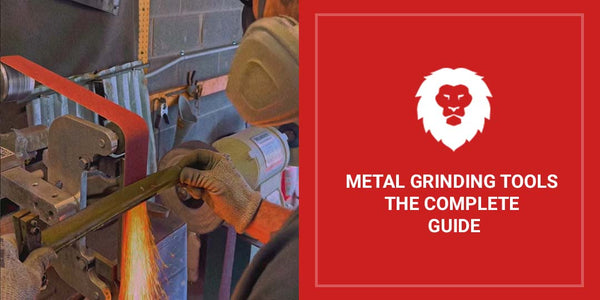You can cut metal with a grinder by securely clamping the metal and slowly guiding the grinder. Using the appropriate cutting disc and protective gear, ensure safety and accuracy in the cutting process.
Metal cutting with a grinder can be an efficient and effective method for various DIY projects or professional metalworking tasks. With the right technique and precaution, you can achieve clean and precise cuts on different types of metal. Whether you are working on a small craft project or a larger industrial application, mastering the art of cutting metal with a grinder can be a valuable skill.
Understanding the steps involved and practicing proper safety measures will help you accomplish your metal cutting tasks with ease.

Credit: tikweld.com
Getting Started With Metal Cutting
Metal cutting with a grinder is a practical skill that can be useful in various DIY and professional projects.
Choosing The Right Grinder
A crucial first step is choosing the appropriate grinder for your metal cutting tasks. Factors to consider include the grinder’s power, disc size, and overall durability.
Selecting The Right Disc
Equally important is selecting the right disc for your grinder. Abrasive discs are suitable for general metal cutting, while diamond discs are ideal for more precise cuts.
Safety Precautions And Gear
When using a grinder to cut metal, safety precautions and proper gear are crucial to avoid accidents. Here are the key safety measures:
Protective Equipment
- Wear safety glasses with side shields to protect eyes from sparks and debris.
- Use hearing protection as grinders can be noisy.
- Wear a face shield or mask to shield the face from flying particles.
- Put on heavy-duty gloves to protect your hands from heat and sharp edges.
- Wear a long-sleeved shirt and pants to cover exposed skin.
Work Area Safety Measures
- Ensure the work area is well-ventilated to prevent inhaling harmful fumes.
- Remove any flammable materials from the workspace.
- Secure the metal piece firmly with a clamp or vise before cutting.
- Maintain a clean and clutter-free work area to prevent tripping hazards.
- Keep a fire extinguisher nearby in case of emergencies.
Mastering The Cutting Techniques
Cutting metal with a grinder requires skill and precision. By mastering the cutting techniques, you can achieve clean and accurate cuts, ensuring the safety of both the material and yourself. Whether you’re a beginner or a seasoned professional, understanding the basic cutting methods and advanced cutting tips can enhance your efficiency and effectiveness when working with a grinder.
Basic Cutting Methods
When starting out with cutting metal using a grinder, it’s essential to become proficient in the basic cutting methods. Understanding these fundamental techniques lays a solid foundation for mastering the grinder.
- Ensure you have the appropriate type and size of cutting disc for the specific metal you’re working with.
- Secure the metal firmly in place using clamps or a vice to prevent slippage during the cutting process.
- Wear protective gear, including safety goggles, gloves, and a face mask, to safeguard yourself from potential sparks and metal fragments.
- Maintain a steady hand and apply gentle pressure as you guide the grinder along the cutting line, allowing the disc to do the work.
Advanced Cutting Tips
Once you’ve mastered the basic cutting methods, incorporating advanced cutting tips can elevate your cutting precision and efficiency. These tips are particularly beneficial for achieving intricate cuts and enhancing overall workmanship.
- Utilize a guide or template to ensure straight, precise cuts without veering off course.
- Regularly inspect and replace cutting discs as needed to maintain sharpness and reduce the risk of disc breakage.
- Employ the use of cooling agents, such as cutting fluid or lubricant, to prevent overheating and extend the lifespan of the cutting disc.
- Experiment with different cutting speeds and angles to ascertain the optimal approach for various metal thicknesses and compositions.
Maintaining Your Grinder For Longevity
A grinder is an essential tool for cutting metal efficiently and effectively. However, to ensure its longevity and optimal performance, proper maintenance is crucial. By following a few simple steps for cleaning, lubricating, and sharpening or replacing discs, you can keep your grinder in top shape for years to come.
Cleaning And Lubricating
Regularly clean your grinder after each use to prevent build-up and maintain its cutting efficiency. After turning off and unplugging the grinder, use a brush or compressed air to remove any metal shavings, dust, or debris from the tool and disc. Ensure you clean the vents and the motor housing thoroughly.
- Wipe down the disc and guard with a damp cloth to remove any remaining residue.
- Inspect the power cord for any signs of damage or wear and tear. Replace it if necessary.
Lubricate the grinder regularly to prevent the motor from overheating and the disc from wearing out prematurely. Refer to your grinder’s manual to identify the appropriate lubricant to use.
- Before applying lubricant, make sure the grinder is clean and dry.
- Apply a small amount of lubricant to the rotating parts of the grinder, avoiding contact with the disc.
- Wipe off any excess lubricant to prevent it from attracting dust and debris.
Sharpening And Replacing Discs
Regularly inspect the cutting disc for signs of wear, such as dullness or chipping. If the disc’s cutting performance is compromised, it’s crucial to sharpen or replace it promptly.
Sharpening the disc:
- Put on safety goggles and gloves before handling the disc.
- Secure the disc in a vise or using a disc holder.
- Use a diamond file or sharpening stone to re-establish the cutting edge. Follow the manufacturer’s instructions for proper sharpening techniques.
- Clean the disc after sharpening to remove any metal particles.
Replacing the disc:
- Ensure the grinder is turned off and unplugged before replacing the disc.
- Locate the disc release button or locking nut and use the appropriate tool to loosen it.
- Remove the old disc and dispose of it properly.
- Align the new disc with the grinder’s spindle and secure it by tightening the release button or locking nut.
- Double-check that the disc is properly positioned before using the grinder again.
Creative Metal Cutting Projects
When it comes to metalworking, using a grinder to cut metal is often a go-to tool for many DIY enthusiasts and professionals alike. But did you know that a grinder can be used for more than just simple cuts? With a bit of creativity, you can take your metal cutting projects to a whole new level. In this blog post, we will explore some creative metal cutting projects that you can undertake using a grinder.
Making Clean Cuts For Welding
If you are planning to weld metal pieces together, it is crucial to make clean, precise cuts. This ensures a tight and secure fit, resulting in a stronger weld. When using a grinder for cutting metal, there are a few tips and techniques you can employ to achieve clean cuts:
- Use a high-quality cutting blade to minimize rough edges and burrs.
- Maintain a steady hand and apply consistent pressure to the grinder as you cut through the metal.
- Regularly check the alignment of your cut, making adjustments if necessary, to ensure a straight and accurate line.
- After cutting, use a file or sandpaper to smoothen any rough edges or imperfections.
Creating Intricate Designs
Not only can you make clean cuts with a grinder for welding purposes, but you can also use it to create intricate designs on metal surfaces. Whether you want to add decorative accents to furniture, personalize metal signs, or create unique art pieces, a grinder can be your tool of choice. To achieve intricate designs, consider the following:
- Use different grinding attachments like flap discs or cutoff wheels to create various effects and textures on the metal.
- Experiment with different speed settings on your grinder to control the depth and intensity of the cuts.
- Mark out your design on the metal surface before cutting, allowing you to have a guide to follow and maintain consistency.
- Practice on scrap metal pieces before working on your final project to gain confidence and perfect your technique.

Credit: www.redlabelabrasives.com
Frequently Asked Questions For Cut Metal With Grinder
Can A Grinder Cut Through Metal?
Yes, a grinder can cut through metal. With the right disc and proper technique, grinders are great for shaping, cutting, and removing metal. Just make sure to wear appropriate safety gear and take necessary precautions while using a grinder for metal cutting tasks.
What Type Of Grinder Is Best For Cutting Metal?
Angle grinders are the most suitable type of grinder for cutting metal. They provide a high level of control and maneuverability, allowing precise cutting and shaping. Choose a grinder with a cutting disc specifically designed for metal cutting to ensure efficiency and safety.
How Do You Cut Metal With A Grinder?
To cut metal with a grinder, start by securing the workpiece firmly. Use a metal-cutting disc and hold the grinder at a slight angle while applying light pressure. Allow the grinder to do the work and avoid forcing it. Move the grinder smoothly along the cut line, using steady strokes until the desired cut is achieved.
Is Cutting Metal With A Grinder Safe?
While cutting metal with a grinder can be safe when proper precautions are followed, it comes with risks. Always wear safety goggles, gloves, a dust mask, and hearing protection. Avoid excessive pressure, keep a firm grip on the grinder, and maintain a safe working area.
Familiarize yourself with the grinder’s operating instructions and practice safe handling.
Conclusion
Using a grinder to cut metal is a versatile and efficient method that yields precise results. By following safety precautions and selecting the appropriate grinder and cutting wheel, professionals and DIY enthusiasts can achieve clean cuts on various metals. With practice and the right techniques, mastering this skill can lead to successful metalworking projects.


